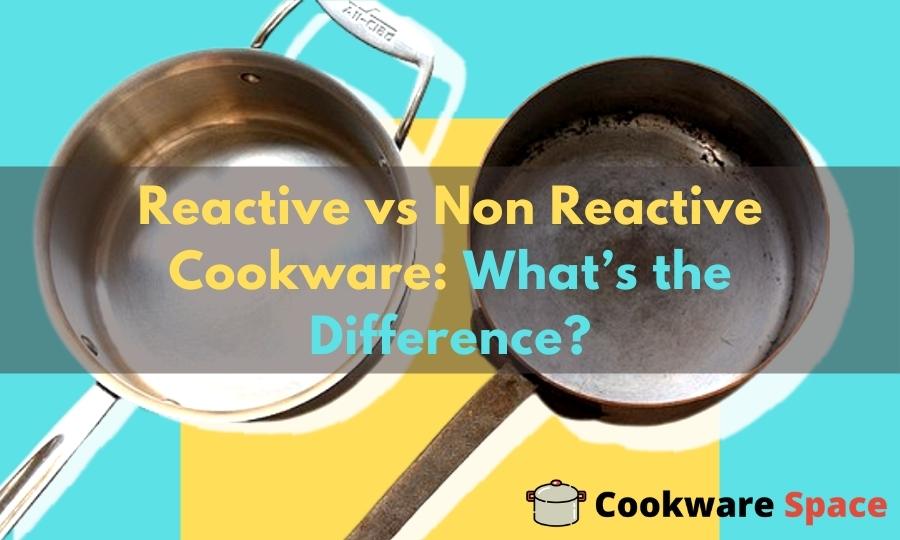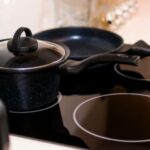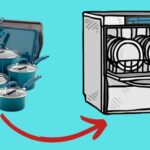Reactive vs Non Reactive Cookware: What’s the Difference

In our daily life we all come across different types of dishes and cookware types. The choice of cookware we use for our food preparation is very important as it can affect both the taste and health of our food.
It is important to be aware of the difference between reactive and non reactive cookware, so that you can choose the best option for your.
Reactive vs non reactive cookware: The main difference between a non-reactive and a reactive pan lies in the type of material used to make it.
Reactive cookware has a surface that is chemically active, reacting with acidic foods and causing them to change color or flavor.
Reactive cookware is made of copper, aluminum and cast iron. So you have to be careful not to let it touch acidic foods like tomatoes or anything with a high acid content as they will react chemically with the food and ruin your dish.
Nonreactive cookware on the other hand is made of stainless steel, glass and some ceramic coated cookware. Non-reactive cookware is made from materials that do not react with acidic ingredients like tomato sauce and lemon juice.
Reactive Cookware
Reactive cookware is made of a material which reacts with acidic food like tomato sauce and it leaches out the toxic compounds like lead into your food.
These compounds are not good for health in any quantity, but even more so when you consider that most people using this cookware aren’t aware of its dangers. These toxins will also transfer over to your drink if you use a reactive pitcher or kettle.
The most common type of reactive cookware is aluminum. It’s lightweight, affordable and easy to find, but it can also leach toxins into your food.
Stainless steel cookware is a better option as it doesn’t react with acidic foods, but it’s important to make sure that the stainless steel isn’t mixed with any other metals like iron or nickel.
Cast iron is another type of cookware that can react with acidic foods, but there are ways around this problem such as seasoning your cast iron pan before using it for cooking.
If you want to avoid all reactive materials altogether then ceramic coated pots and pans are the way forward.
If you’re concerned about what type of cookware is best for your health then it might be wise to invest in some stainless steel or ceramic coated pots and pans instead of aluminum ones which can easily react with acidic foods.
Some of the acidic foods are Tomatoes, lemon/lime juice, vinegar are good examples of some common acids that we cook with on a regular basis
Types of Reactive cookware
Aluminum and copper are two examples of reactive materials that are often used in cookware.
Copper is a highly reactive material and it will react with acidic ingredients, like lemon juice or tomato sauce.
Aluminum has low reactivity but it can still be considered reactive because the reactions between aluminum and acidic foods may cause an unpleasant metallic taste to develop in food cooked in this type of pan.
Aluminum cookware can also cause discoloration of your food if you add acidic ingredients like lemon juice or tomato sauce to the pan when they are hot.
When cooking these foods in reactive pans such as aluminum or iron you should always use an acid resistant coating to prevent the acid from reacting directly with the metal. Acid resistant coatings can be found in stainless steel, enamel cookware or a nonstick ceramic coating.
Traditionally, we always use stainless steel for cooking acidic foods like tomato sauce (or any other acidic sauces). But if you want an alternative, there are other options such as enameled cast iron pots or non-stick cookware which will not react with these types of foods.
Benefits of Reactive cookware
- Reactive materials like copper and aluminum heat up quickly and evenly, making them ideal for cooking foods that require high temperatures.
- Pans are inexpensive as compared to reactive cookware
Drawbacks of Reactive cookware
- The main disadvantage of reactive pans is that they can react with acidic ingredients, causing food to change color or develop a metallic taste.
- Reactive pans can also be heavy and difficult to maneuver, especially when full of food.
Non Reactive Cookware
Non reactive cookware is made of a material which does not react with acidic food like tomato sauce and it does not leach out any toxins into your food.
The most common type of non reactive cookware is stainless steel. Aluminum is also a non reactive material, but it can corrode over time if used with acidic food.
Titanium is another option for non reactive cookware and it is lightweight and durable. It does not corrode or tarnish like aluminum.
Type of Non-reactive cookware
Non reactive stainless steel, cast iron and nonstick pans are made from materials that do not react with foods containing acid in them.
Stainless steel is the best example of a non-reactive material.
Non reactive cookware has many advantages over reactive cookware which are mentioned below
Benefits of Non reactive cookware
- Nonreactive cookware is made from materials that do not react with food.
- This means that the food will not change color, taste, or smell when it is cooked in these pots and pans.
- Pans are easy to clean because there is no risk of food sticking and causing a mess.
- Doesn’t react with acidic ingredients, so there is no risk of changing their flavor or color.
- Pans are durable and will last for many years if they are well cared for.
Drawbacks of Non reactive cookware
- This type of cookware is more expensive than other options on the market.
- Non reactive pans can also be heavy and difficult to maneuver, especially when full of food.
- Another issue with non reactive material is that they do not conduct heat as well.
Which one is better for you? Non reactive or Reactive cookware?
It all depends on your needs as a cook. If you are looking for an easy-to-clean pan that won’t react with acidic ingredients, then a non reactive option is the best choice for you.
If you are looking for a pan that heats up quickly and evenly, then a reactive material like copper or aluminum may be a better fit. Ultimately, it’s up to you to decide which type of cookware works best for your individual cooking style.
Related Posts:




